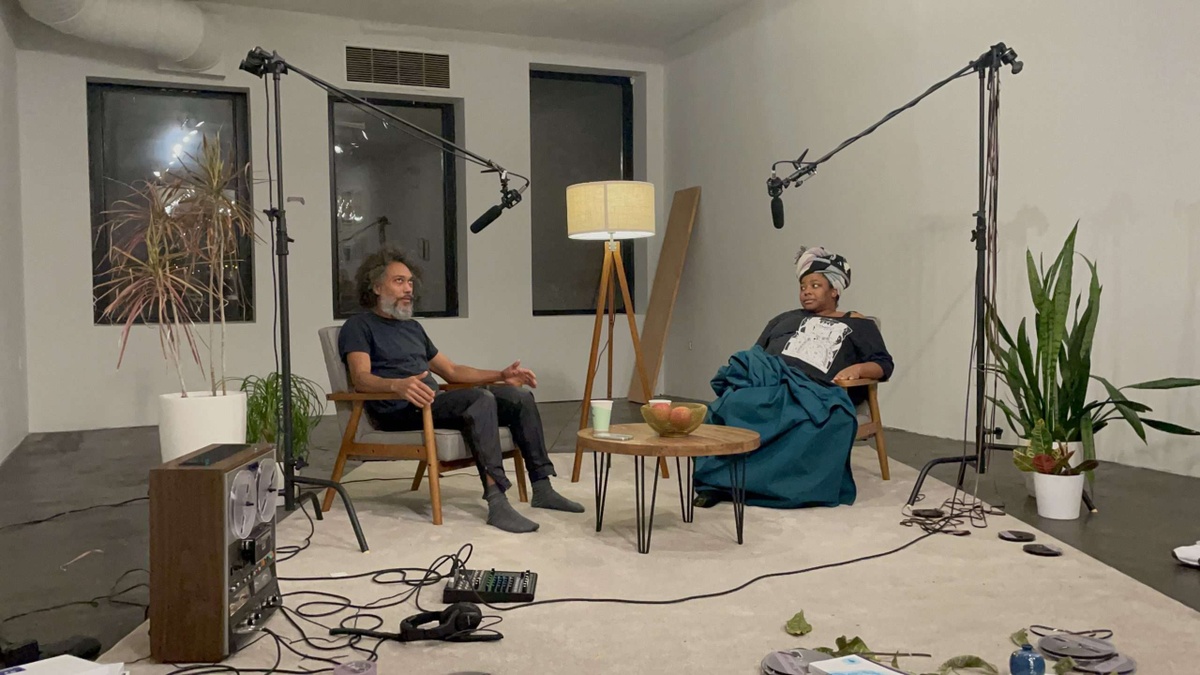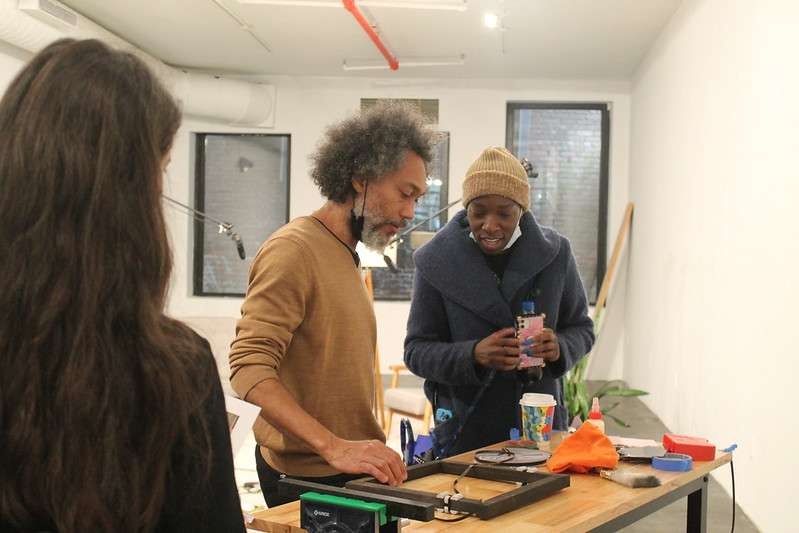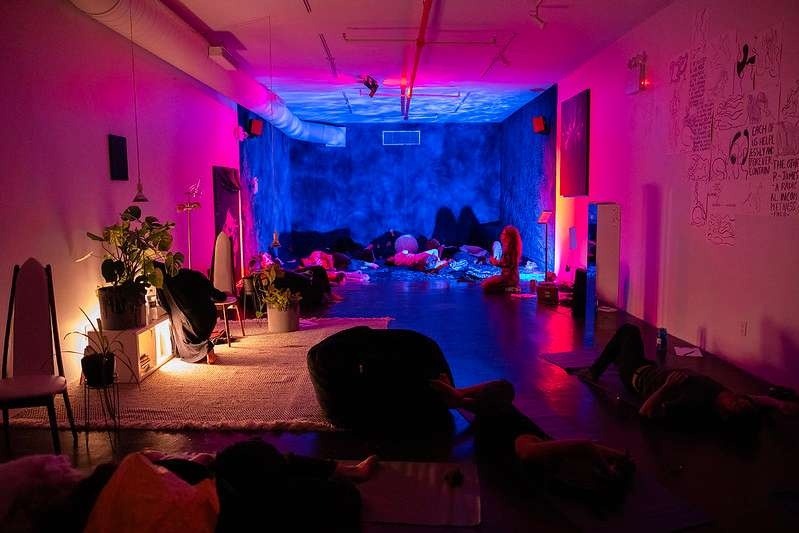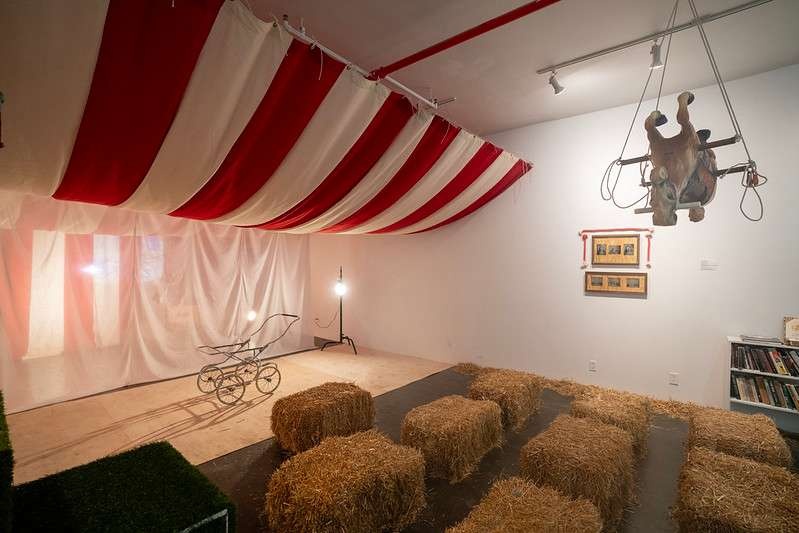Enter a living room. Curated yet quotidian, the art happens here.
Here, where books, fallen leaves from potted plants, empty tape packets are splayed around on a creamy brown rectangular rug laid in the Recess Session gallery. Drawings from I Clean Avenue Canada (2010) hang on the walls at the entrance. Iron ore pigments wash over white paper smudged by a body that previously moved through the industrial mining locale in Jardim Canadá. Oranges and apples fill a bowl on a small white stool, there are chairs for two people to converse, recording devices and microphones occupying the middle and edges of the space. The composition of this social installation, so to speak, was influenced by the portrait studio practices of Seydou Keïta and Malick Sidibé. Thinking about a photographic and partly sonic practice side by side, it becomes apparent what Sidibé, Keita, and Zachary Fabri’s Black Tape Ebony Frame encompass: presence, relation, an intent to record once-living moments in the most organic way their mediums and perspectives allow. To document as real as the memory itself. Fabri fittingly describes this setting as a tableau for sociality; this semi-architectonic composition that can as well be an everyday scene set the stage for sharing, listening, and happenings sprouting in the space between.
Black Tape Ebony Frame initially began as a project to document Fabri’s father’s stories as a political refugee from Hungary in 1956, but in a continuous wake where varying degrees of anti-blackness refuse to wither, the project was expanded to contemplate such atmosphere from individual and collective perspectives. As part of the programming, Fabri held analog, tape-recorded conversations with his friends and collaborators about art practices, current interests, friendship, history, archiving, and cultural matters writ large. Fabri named some sessions “stoop sessions” and did not publicly record them, adopting the stoop/porch as a black vernacular space of relation, as a form of making kin in the same tenor that mereba sings about: “I’ve been chilling with my kinfolk…Diggin’ for our hidden treasures.” Leaning into a process that favors kinship and camaraderie over more formally strict procedures of making art, the project shares a loose resonance with what Fred Moten and Stephano Harney describe as “study” in their book The Undercommons. Study is social: “what you do with other people…the working, dancing, suffering, some irreducible convergence of all three, held under the name of speculative practice.” [1] Against the over-institutionalization of school-based instruction, study hearkens to the kind of learning that takes place at the kitchen table, after a meal, or amongst the young and elders gathered together on a raffia mat under a gleaming crescent moon.


Zachary adding tape during a conversation
By embracing fluidity and the dynamism of study, Fabri created a generative space, a porous one too, where linearity dissolved and previously unthought topics flush out. Thought and speech occasionally recombined, strayed, and wound back on themselves. For instance, in a session with artist and poet Adjua Gargi Nzinga Greaves, there were connections from the conceptual underpinning of braiding (as in community) to the physical act of braiding (as in intimacy), evident in the question Greaves asked: who have you allowed to braid your hair? The sessions’ casualness revealed itself in how many elements—sounds from outside the conversation space, remarks from the audience, and even divergences from within the space—commingled to create its own moment. Often during the sessions, the tape would stop recording but the conversations continued. As had happened in Greaves’ session, most of the audience collectively entertained the possibility that the recording devices achieved sentience to include itself in the conversation.
With Black Tape Ebony Frame, Fabri explores ownership, archiving as remembrance and refusal, and queries immortality in an age of high technological advancement. The shifting relationship to recording and not, with the presence of recordings that fail, underscores Fabri’s interests in black embodiments and the incessant commodification, surveillance, and pervasive forms of data extraction. Fabri intends to wind the analog audio tapes around an ebony frame made from wood only grown in specific places in Asia and Africa. Small, square, with the black tape forming lines across frames, these might look on first sight as work that plays with an abstract minimalist form, but Fabri is hesitant to give these objects a fixed assignment. He has a nominal preference for “holders,” functioning outside of what frames usually do, or “vessels,” being both formal and symbolic responses to initial questions on ownership, autonomy, and the possible ways to safeguard black subjectivities against commodification.[2]


Zachary in conversation with with artist and poet Adjua Gargi Nzinga Greaves
Black Tape Ebony Frame does not present a grand gesture of resistance but is a subtle defiance. There is the minimalism that is not invested in spectacle, that pipeline for easy assimilation into commodity. The objects—frames—from Black Tape Ebony Frame gesture toward an alternate, expansive kind of visibility: not everything present is always visible, not everything that is rendered tangible must become commodity. Through systems of documentation, with external perceptions using analog and digital tools, black subjectivity is hypervisible, more so in a way that is not autonomously managed. Perception itself is often beholden to a will to flatten, corrupt, or appropriate. If we consider both analog and digital commodification of black life as an exploitative order, these objects made from a process focused more on relation move away from such norm. Circling back to Moten and Harney’s notion of the undercommons as a space produced by small shifts, what can be seen in these objects are gestural dislocations, formal breaks, a material divergence from the enforced commodity commons encircling living spaces both in front and off the screen. [3]The frame’s utility shifts to an almost static circulation that disavows rampant exploitation.
Using objects as proxy has been a recurrent motif in Fabri’s practice. Although the previous project, I Clean Avenue Canada, attended to different concerns specific to that site, it shows Zachary Fabri’s process of using performance and gesture as a means of reasoning. Fugitive gestures are made material in Black Tape Ebony Frame. By creating space for kinship, allowing diversions, or using semi-obsolete technology, these gestures encode the resulting frames as an analog opacity to the standards of digital capture and technological transparency. Accessing these tapes will require increasingly obsolete technology, thereby proving difficult for someone who is not intending to spend time but wants absolute transparency and desires excessive explication. If one is not willing to kin with it, ring-around-da-roses with it, accept the invitation to fill in the gaps with speculation, one gets nothing.


Zachary showing the frames to a visitor
As blackness continues to have an inseparable bind with commodity, Fabri’s Black Tape Ebony Frame can funnel inspiration to imbibe fugitive practices that shift these extensions of our embodiment, nowadays couched as “content.” In making material proxy objects of gestures, the possibility of liberating parts of ourselves from the commodity commons is made more real. In an era when black TikTokers strike, refusing to create content in response to how their gestures, dance styles, and accents are stolen by and misattributed to non-black peers, it becomes imperative to explore these questions along with Fabri. This may mean extending questions of ephemerality and algorithmic opacity—how a tool like Instagram qualifies through its own secretive metrics. Who owns the archive and who has access to it? When technology industries are built on procedures of planned obsolescence, how can we collect and remember?
Black Tape Ebony Frame reminds us of our intrinsic potential to exceed the physical and immaterial strictures we are seemingly bound by, finding pockets of freedom and moving in ways that playfully and poetically bypass the full force of technological oppression. Fabri conceives the body as a recorder, memories being what the audience takes from the session. While the digital continues to digitize, we can collectively consider how we extend our embodiment, and even connive with what was already provided; to abide more with the body, presence, moments, stay with these provisions like it is all we have.
Footnotes
-
Fred Moten and Stefano Harney, The Undercommons: Fugitive Planning & Black Study (United Kingdom: Minor Compositions, 2013), 110.
-
Zachary Fabri, Project Statement.
-
Moten and Harney’s theoretical framework of the undercommons as a “break piece” (Pg. 149) is applied in a rotary way to envision what that could mean when made material. To ask what fugitive objects could look like? Are objects in the undercommons too?
About the artist
Adéolá Olákìítán
Adéolá Olákìítán is a writer and transdisciplinary curator working between Lagos and New York. Their praxis is invested in poetics, marginal technopolitics, and queer spiritations. They wrote and collaborated with Alexander Si on their artist book WHISKERY SQUID (MEMOIRS), published by 24EBROADWAY.
Explore/Archive
See allDecember 2025
The INSTITUTE FOR TRANSHUMANIST CEPHALOPOD EVOLUTION and Learning from Octopuses
Barbara London
Barbara London reflect's of Miriam SImun's INSTITUTE FOR TRANSHUMANIST CEPHALOPOD EVOLUTION
October 2025
streamlined reflections, courtesy of noise canceling headphones
Gabrielle Rucker
Gabrielle Rucker reflects on the radical intimacy and auditory life at the heart of Deli Radio
July 2025
Tell My Jockey: CUNTRY’s Discourse From the Horse’s Mouth
Ericka Pérez
Assembly fellow Ericka Pérez reflects on clowning, resistance, and CUNTRY’s radical refusal to perform.





